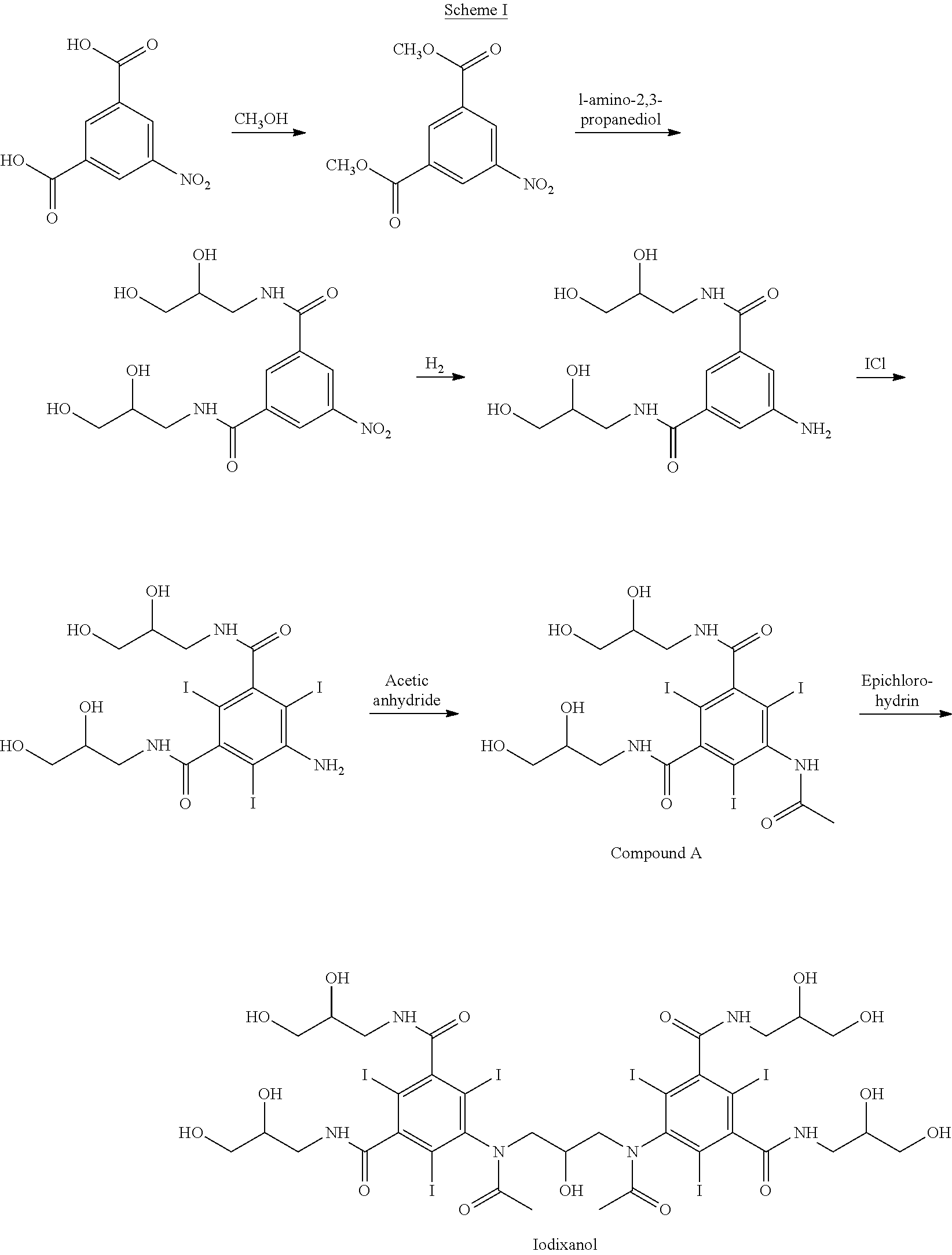Preparation and Purification of Iodixanol
a technology of iodixanol and purification process, which is applied in the field of preparation and purification of iodixanol, can solve the problems of low purity, high cost and time consumption of the purification process of the final product, and low yield of the whole process of this process, so as to improve the process of preparing iodixanol
- Summary
- Abstract
- Description
- Claims
- Application Information
AI Technical Summary
Benefits of technology
Problems solved by technology
Method used
Image
Examples
example 1
[0084]Compound A (1120.5 kg, 1.50 kmol) was dissolved in a solution of KOH (140.0 kg, 2.25 kmol) in water (1232.6 kg), the temperature was controlled to below 20° C., boric acid (64.9 kg, 1.05 kmol) was equally added in a batch manner, and hydrochloric acid (30.4 kg, 0.30 kmol) was added dropwise, followed by epichlorohydrin (83.3 kg, 0.90 kmol), which was added dropwise. The pH during the reaction is 10-11. The reaction was monitored and a sample was analyzed by HPLC. The reaction was quenched by adding water (1232.6 kg) and adjusting the pH to within the range 5-6 with 18% of hydrochloric acid when the content of Compound A was below 5%.
[0085]The reaction mixture was then decolorized with active charcoal and filtered. The filtrate contained 86.3% of iodixanol, 7.5% of iohexol, 2.9% of compound A and 2.7% of O-alkylated by-products and other impurities by HPLC analysis.
example 2
[0086]Compound A (1120.5 kg, 1.50 kmol) was dissolved in a solution of NaOH (78.0 kg, 1.95 kmol) in water (1232.6 kg), the temperature was controlled to below 20° C., boric acid (51.0 kg, 0.83 kmol) was equally added in a batch manner, and hydrochloric acid (23.3 kg, 0.23 kmol) was added dropwise, followed by epichlorohydrin (83.3 kg, 0.90 kmol), which was added dropwise. The pH during the reaction is 10-11. The reaction was monitored and a sample was analyzed by HPLC. The reaction was quenched by adding water (1232.6 kg) and adjusting the pH to within the range 5-6 with 18% of hydrochloric acid when compound A content was below 5%.
[0087]The inorganic ions were removed by passing through a column containing anionic and cationic ion exchange resins and then decolorized with active charcoal; the filtrate was concentrated by evaporation to dryness giving iodixanol crude product (1163.0 kg).
[0088]The contents by HPLC were 85.0% of iodixanol, 7.1% of iohexol, 3.0% of compound A, 2.9% of ...
example 3
[0089]Compound A (11.2 kg, 15.0 mol) was dissolved in a solution of NaOH (0.96 kg, 24.0 mol) in 2-methoxyethanol, the temperature was controlled to below 20° C., boric acid (0.65 kg, 10.5 mol) was equally added in a batch manner, and hydrochloric acid (0.55 kg, 5.4 mol) was added dropwise, followed by epichlorohydrin (0.75 kg, 8.1 mol), added dropwise. The pH during the reaction is 10-11. The reaction was monitored and a sample analyzed by HPLC. The reaction was quenched by adding water (12.3 kg) and adjusting the pH to within the range 5-6 with 18% hydrochloric acid when the content of Compound A was below 5%.
[0090]The reaction mixture was then decolorized with active carbon. The filtrate contained 84.2% of iodixanol, 5.1% of iohexol, 4.8% of compound A and 2.5% of O-alkylated by-products and other impurities by HPLC analysis.
PUM
| Property | Measurement | Unit |
|---|---|---|
| Temperature | aaaaa | aaaaa |
| Temperature | aaaaa | aaaaa |
| Temperature | aaaaa | aaaaa |
Abstract
Description
Claims
Application Information
 Login to View More
Login to View More - R&D
- Intellectual Property
- Life Sciences
- Materials
- Tech Scout
- Unparalleled Data Quality
- Higher Quality Content
- 60% Fewer Hallucinations
Browse by: Latest US Patents, China's latest patents, Technical Efficacy Thesaurus, Application Domain, Technology Topic, Popular Technical Reports.
© 2025 PatSnap. All rights reserved.Legal|Privacy policy|Modern Slavery Act Transparency Statement|Sitemap|About US| Contact US: help@patsnap.com

